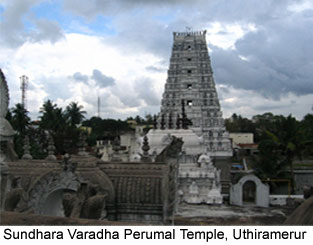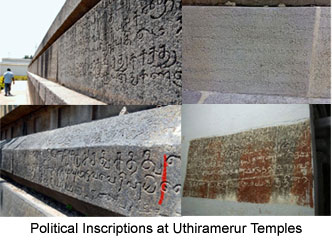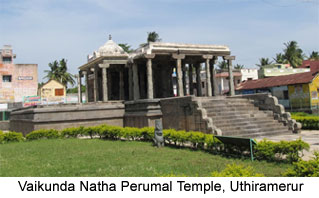 Uthiramerur is a panchayat town located in the Kanchipuram district of the Indian state of Tamil Nadu. Distanced around 90 kilometres from the capital city Chennai, Uthiramerur is known for the unique inscriptions relating to politics found at the temples that have been established in the town, tracing as back as the 8th century. These inscriptions elucidate a self-governance system that was prevalent during that time.
Uthiramerur is a panchayat town located in the Kanchipuram district of the Indian state of Tamil Nadu. Distanced around 90 kilometres from the capital city Chennai, Uthiramerur is known for the unique inscriptions relating to politics found at the temples that have been established in the town, tracing as back as the 8th century. These inscriptions elucidate a self-governance system that was prevalent during that time.
Uthiramerur is located in Kanchipuram district in the Indian state of Tamil Nadu. It is a panchayat town established by the Pallava king Nandivarman II in 750 A.D. The town has been ruled by powerful rulers of the Chola Dynasty, the Sambuvarayar Dynasty, Nayak Dynasty, the Pallava Dynasty, the Pandya Dynasty and the Vijayanagar Empire.
History of Uthiramerur
During several excavations conducted in the town of Uthiramerur, stone edicts and carvings have been found of the Chola Dynasty. These suggest about the local self governance that prevailed during that period. The elections were held at the time by a method known as Kudavolai. The edicts found have been named as Uthiramerur Kalvettu after the name of the place. Many inscriptions dating around 920 A.D have been found on the walls of the village assembly (grama sabha mandapa). These walls have been constructed of granite slabs and are all rectangular in shape. These inscriptions suggest that the village had a written constitution as well as an electoral system prevailed here. The constitution laid down about the different modes of elections. These inscriptions in the reign of Parantaka Chola are regarded as significant historical record. The Kailasanathar temple located in the town has been recently renovated and repaired by the REACH foundation.
Demographics of Uthiramerur
As per the 2011 Census India report, the total population of the Uthiramerur panchayat town stood at 25,194. Of the total number of inhabitants, 12,569 comprised males and 12,625 comprised females. The population of children between 0 to 6 years of age was 2,554, 10.14 % of the total population. The Female Sex Ratio stood at 1,004, higher than the state average of 996 and the Child Sex Ratio was around 917, compared to the state average of 943. The effective literacy rate of Uthiramerur was 81.74 %, higher than the state average of 80.09 %, with male literacy being 89.17 % and female literacy rate at 74.42 %. Uthiramerur panchayat town administrates over 6,197 households, supplying them basic amenities like water and sewerage.
Political Inscriptions at temples at Uthiramerur
The four important Hindu temples in Uthiramerur are - Vaikunda Natha Perumal Temple, Sundhara Varadha Perumal Temple, Balasubramania Swamy Temple and Kailasanatha Temple.
The Vaikunda Natha Perumal Temple, which is under the Archaeological Survey of India (ASI), has its all four sides highlighted with political inscriptions that were recorded by Chola king Parantaka I (907-955 CE), focussing on the evolution of the administrative system with the transfer of executive powers from "variyars" (individuals) to "variyams" (committees). Each "variyam" constituted 6 to 12 members, who were elected following certain specific rules, highlighted in the inscription dating 921 CE, which also says that the village had 30 "kudumbus" or wards for which members were elected annually. The rules for a member nominee highlighted are:
1. Must own tax-paying land of at least quarter of a `veli` (about an acre and a half), or one-eighth of a "veli" if knowledgeable in at least 1 Veda and 1 Bhashya.
2. Must reside in a house built on self-owned land.
3. Must be aged between 35 and 75 years.
4. Must be knowledgeable in "mantras" and the Brahmanas (Vedic Literature).
The rules also highlighted certain disqualifications in being a nominee:
•Existing committee member of any committee, for the past 3 years.
•Existing committee member who (or whose relatives) had failed to submit accounts.
•One who (or whose relatives) has committed incest (sexual activity between family members) or any of the five great sins (being killing a Brahmin, drinking alcohol, theft, adultery and associating with criminals).
•One who has been an outcaste for association with low caste (unless he performs expiatory ceremony or purification).
•One who is foolhardy.
•One who had stolen the property of others.
•One who had consumed "forbidden dishes".
The tenure of an elected committee member was 360 days and anyone found guilty of an offence during the term was immediately removed from office. The Uthiramerur inscriptions indicate that parading on a donkey was the punishment for offences such as incest, adultery, theft and forgery.
 The Sundhara Varadha Perumal Temple is around 1200 years old, built under the reign of the Pallava king Nandivarman II. It is a 3-tiered temple, said to have been constructed by the mason Paramesa Vathan who was very skilled in "vastu shastra". The main deity in the temple is Lord Sundhara Varadha Perumal. This temple too has numerous inscriptions such as those of the king Rajaraja Chola (985 to 1015 AD), his able son Rajendra Chola and the Vijayanagar emperor Krishnadevaraya. The rituals in the temple are performed as per Vikhanasa Aagama following the Krishna Yajur Veda. The temple"s "gopuram" (ornate monumental tower) was rebuilt in 1998, showcasing rich sculptures of some of the Hindu Gods, mostly incarnations of Lord Vishnu. It showcases Sri Vikhanasa Acharya with his four disciples, Goda Devi, Sudarshana, Sri Rama Parivar and many other sculptures resembling "vikhanasa sutra". The distinct aspect about this historical temple is that there are 9 "mula virats" (main deities) in all the 3 tiers, with 4 deities on the first and second tiers and 1 deity in the third tier. This is the only Vaishnavite temple in India with 9 deities in a three tier structure. Hence, this is referred to be a "Nava Murthy Sthalam" (abode of nine deities). It was the belief that a Nava Murthy can be installed only where over a 1000 Brahmins recite the Vedic Paaraayanam. This indicates that Uthiramerur was a hub of Vedic learning in those days.
The Sundhara Varadha Perumal Temple is around 1200 years old, built under the reign of the Pallava king Nandivarman II. It is a 3-tiered temple, said to have been constructed by the mason Paramesa Vathan who was very skilled in "vastu shastra". The main deity in the temple is Lord Sundhara Varadha Perumal. This temple too has numerous inscriptions such as those of the king Rajaraja Chola (985 to 1015 AD), his able son Rajendra Chola and the Vijayanagar emperor Krishnadevaraya. The rituals in the temple are performed as per Vikhanasa Aagama following the Krishna Yajur Veda. The temple"s "gopuram" (ornate monumental tower) was rebuilt in 1998, showcasing rich sculptures of some of the Hindu Gods, mostly incarnations of Lord Vishnu. It showcases Sri Vikhanasa Acharya with his four disciples, Goda Devi, Sudarshana, Sri Rama Parivar and many other sculptures resembling "vikhanasa sutra". The distinct aspect about this historical temple is that there are 9 "mula virats" (main deities) in all the 3 tiers, with 4 deities on the first and second tiers and 1 deity in the third tier. This is the only Vaishnavite temple in India with 9 deities in a three tier structure. Hence, this is referred to be a "Nava Murthy Sthalam" (abode of nine deities). It was the belief that a Nava Murthy can be installed only where over a 1000 Brahmins recite the Vedic Paaraayanam. This indicates that Uthiramerur was a hub of Vedic learning in those days.
The Balasubramania Swamy Temple has a shrine for the Vel weapon of Lord Muruga, for the devotees in the northwest corner of the temple. The depth of the Vel is unascertained till date. It is also noteworthy that Valli and Deivanai consorts of Lord Muruga are in one form as Gajavalli, a rare and different tradition from other Muruga temples. The Aipasi Annabishekam and the Skanda Sashti festivals are celebrated in the temple during October and November, along with Karthikai Deepam during November and December.
Presently, the Uthiramerur town is administered by a town panchayat. It is divided into 18 wards, for which elections are held every 5 years.



















